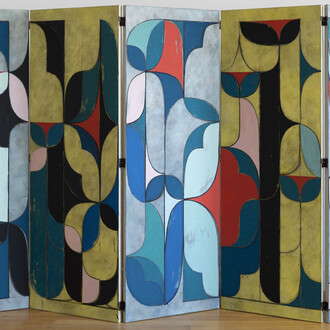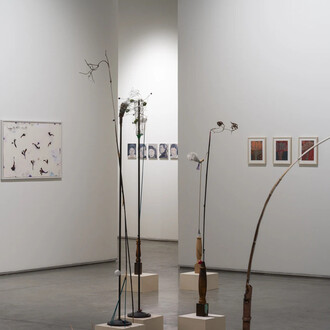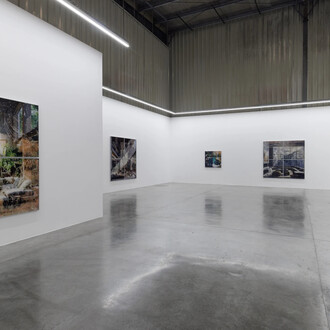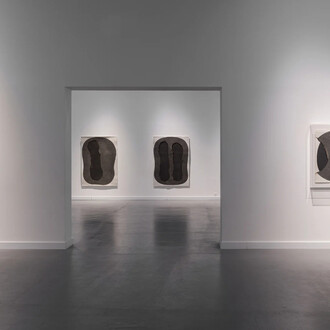Ayyam Gallery Dubai is pleased to announce Ripples, the solo exhibition of painter Mohannad Orabi.
Ripples will highlight a new body of work by the Dubai-based Syrian artist. With his latest paintings, Orabi seeks to provide a counter image to the death and destruction that most Syrian artists are now widely recording. Over the past year, he has turned to his daily life for inspiration. For example, some of the doe-eyed children that have occupied his canvases since 2012 are depicted with details of his young daughter’s life, such as the bows and ribbons that often signal the initial stage of femininity. Focusing on everyday subject matter provides a creative outlet for the artist as he is deeply affected by the ongoing war in his native country.
In a number of paintings, the sparrows that first appeared in Orabi’s work a decade ago have returned to sit at the feet of buoyant children who are shown at peace in the world. According to the artist, this imagery invokes his memories of Syria before the war, whereas the built up surfaces of his canvases, which are covered in layers of sand, refer to his new life in the UAE and the years that have passed since he left Damascus. Glistening hues of paint mixed with sand represent the various environments of the Emirates. Different earth tones indicate desert landscapes; an abundance of white suggests the vividness of sundrenched streets; and cool blues recall the bordering sea.
A central image of the exhibition is a portrait of a child surrounded by a star-filled night sky wearing a deep red cloak. The gender of the child is left ambiguous, much like the vibrant self-portraits Orabi painted while still living in Damascus. A full moon seems to illuminate the child as they stare directly at the viewer, causing the rich textures of their patterned robe to shimmer. Here, as in other recent paintings, Orabi describes a borderless world where children are free to flourish. His figure is sculptural with a new sense of dimensionality that he has introduced into his compositions using diverse media—materials that tie his subjects to a shared earth.
With a strong focus on experimentation, Orabi has also explored the use of iron to create stand-alone works, as he seeks to emphasise the contours of his figures: circular forms patterned after the ripples left by stones when thrown into deep waters.
The formal and conceptual aims of Mohannad Orabi’s expressionist painting style are based on the inherent psychology of portraiture in compositions that depict a revolving cast of characters. Initially inspired by the confessional elements and sense of freedom that are found in children’s drawings, Orabi has worked without fixed directives for over a decade, allowing the spontaneity of process to result in liberated forms.
Many of Orabi’s early works were painted as self-portraits, and reveal his fascination with the development of consciousness in childhood, particularly the wonder and whimsy of the formative years that first shape our comprehension of the world. Although the artist maintains this interest, his approach to figurative painting has progressed as additional themes enter his work in subsequent series.
With the start of the Syrian uprising and the conflict that followed, Orabi was displaced from his native country and began to depict his characters with realist details as he referenced the various media that are forging a visual repository of the war. Martyr posters, Facebook profile pictures, and other types of filtered or composed imagery serve as source material for portraits of Syrians under siege, displaced, and in exile, recording a side of the conflict that lies beyond its ideological divisions and political talking points. While the artist continued to reference the various stages of childhood, his displacement led him to consider the ways in which visual culture, social media, and digital communication have become substitutes for what was once tangible.
With his 2016 Mu’allaqat series, Orabi explored the formalism of drawings and cutouts—media that have sustained his practice as he adapts to life in exile. His most recent paintings not only invoke his earlier works but also reflect the poetics of intuitive creation as he searches for new ways to address and describe his experiences.
Born in Damascus in 1977, Mohannad Orabi currently lives and works in Dubai. Orabi graduated from the Faculty of Fine Art, University of Damascus in 2000, and won the first prize in The Syrian National Young Artists Exhibition in 2006. Solo and group exhibitions for the artist include Ayyam Gallery Beirut (2016, 2014); Den Gallery, Kuwait (2016); Fondazione Giorgio Cini, Venice (2015); Ayyam Gallery London (2014); Ayyam Gallery Jeddah (2013); Ayyam Gallery DIFC, Dubai (2015, 2014, 2012); Ayyam Gallery Al Quoz, Dubai (2014, 2009); Ayyam Gallery Damascus (2008), Zara Gallery, Amman (2007); and Ishtar Gallery, Damascus (2006, 2004). In 2014, Orabi was listed among Foreign Policy’s ‘100 Leading Global Thinkers.’














